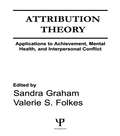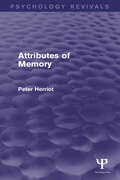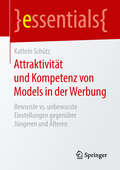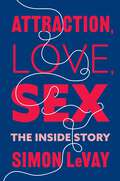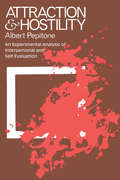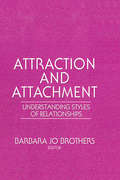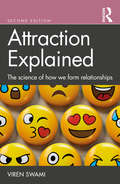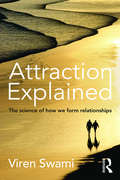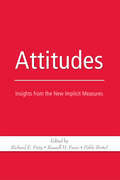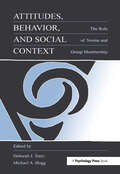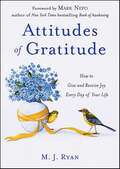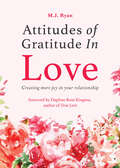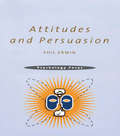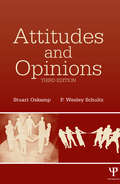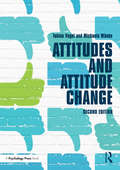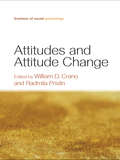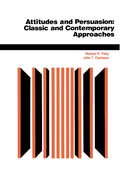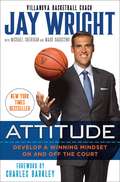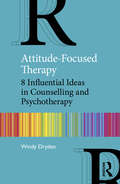- Table View
- List View
Attribution Theory: Applications to Achievement, Mental Health, and Interpersonal Conflict
by Sandra Graham Valerie S. FolkesThis unusual volume begins with a historical overview of the growth of attribution theory, setting the stage for the three broad domains of application that are addressed in the remainder of the book. These include applications to: achievement strivings in the classroom and the sports domain; issues of mental health such as analyses of stress and coping and interpretations of psychotherapy; and personal and business conflict such as buyer- seller disagreement, marital discord, dissension in the workplace, and international strife. Because the chapters in Attribution Theory are more research-based than practice- oriented, this book will be of great interest and value to an audience of applied psychologists.
Attributes of Memory: Attributes Of Memory (Psychology Revivals)
by Peter HerriotFirst published in 1974, Attributes of Memory rejected the prevalent stress on the structure of memory. It suggests that the view of memory as a sequence of stores through which information passes is mistaken. Instead, the author emphasizes the coding process of memory by which the nominal stimulus, the stimulus as presented, is transformed into the functional stimulus, the stimulus as coded. Dr Herriot proposes that there are many different forms of coding, and that efficiency of recall or recognition performance is a function of the nature of coding employed. He suggests that the subject’s linguistic system is the most frequently employed linguistic device; that is, that the underlying attributes and rules of language are used automatically when material is verbal. Since the basic function of language is to communicate meaning, those forms of coding which are meaningful in nature are most effective in memory. The book cites a great deal of experimental evidence, including many studies of the time. As well as stating a point of view, it should be useful to undergraduate and postgraduate students as a review of the early literature, read in its historical context.
Attraktivität und Kompetenz von Models in der Werbung: Bewusste vs. unbewusste Einstellungen gegenüber Jüngeren und Älteren (essentials)
by Kathrin SchützKompakte Einführung in das Thema.<P><P> Anwendungsorientierte Darstellung.<P> Mit praktischen Tipps zur erfolgreichen Werbegestaltung.<P>Dieses essential zeigt, wie sich neben jüngeren auch ältere Models gezielt in der Werbung einsetzen lassen und welche Altersgruppe für welche Produkte und Dienstleistungen geeignet ist. Passen jüngere Models generell besser zu Produkten für jüngere Konsumenten und gilt dies im Umkehrschluss auch für ältere Models? Möchten Jüngere und Ältere von Personen ihres Alters angesprochen werden oder kommt es auf die Passung zwischen Model und Produkt an? Die Autorin gibt einen Überblick über wissenschaftliche Erkenntnisse und untersucht aus Sicht der Jüngeren als auch der Älteren bewusste und unbewusste Einstellungen im Zusammenhang mit Altersstereotypen.
Attraction, Love, Sex: The Inside Story
by Simon LeVaySex, after hunger, may be the most powerful motivating force in our lives. It drives us to seek intimate contact with others and to form relationships that may be fleeting or lifelong, blissful or troubled. Yet many mysteries surround sex and sexuality: Why don’t we reproduce by virgin birth? Why does so much of our sexual behavior have nothing to do with reproduction? Why isn’t everyone heterosexual? How does the brain create sexual arousal? How do sexual kinks develop? Is porn harmful? What is the relationship between sex and love?In Attraction, Love, Sex, the renowned scholar Simon LeVay introduces readers to a memorable cast of researchers trying to answer these questions and many more. A biologist dredges a New Zealand lake for asexual mud snails. Psychologists measure whether eating a good meal changes a man’s idea of female beauty. Physiologists probe orifices with miniature toilet plungers and place lovers in brain scanners. Geneticists reconstruct the sex crimes of Genghis Khan. Neuroscientists create mice whose sexual behavior can be switched on and off. A zoologist traps and releases 260,000 voles and launches a new science of love.LeVay distills vast expertise on the biology and psychology of sex into an engaging and easy-to-understand survey with scientific acumen, a critical eye, and a sense of humor. This book reveals how scientists are unraveling the secrets of sex and, in the process, shattering many traditional ideas and prejudices.
Attraction and Hostility: An Experimental Analysis of Interpersonal and Self Evaluation
by Albert PepitoneAttraction and hostility find expression in almost every variety of human relationship, and have consequently provided a central theme for social psychology since its beginnings. Yet attempts to conceptualize the diverse phenomena embraced in these terms have produced theories of such wide generality that they have little explanatory or predictive force. The object of the present study is to bring precision to a vast and sprawling area by setting limits and dimensions to the phenomena and investigating them experimentally on the basis of a series of hypotheses derived from a critical analysis of current conceptual approaches, including frustration, need-satisfaction, and dissonance models.The programme of experimental studies focuses on cognitive validation-a motivation to form and maintain subjectively valid evaluations of the self and the social environment-which is shown to be a common denominator of a number of attraction and hostility measures. The results throw light on reactions to boastfulness and to self-debasement; impressions of persons who are described by biased informants; effects of self-evaluation on competitiveness, and the projection of unfavourable characteristics.The interest of the study for social psychologists derives both from its theoretical integration of a wide range of behaviour and from its contribution to experimental design.
Attraction and Attachment: Understanding Styles of Relationships
by Barbara Jo BrothersHere is a fascinating exploration of the powerful forces of attachment and attraction that determine the formation and styles of couples’relationships. What factors attract one person to another? What determines whether or not a healthy relationship is formed? As therapists know, there is much in this world that passes for love but is really the result of leftover dependency needs and unresolved attachment issues. Attraction and Attachment: Understanding Styles of Relationships examines issues of attachment in relationships, discusses the validity of the concept of codependency as one aspect of attachment, and explores various aspects of attraction.The contributing authors consider some of the many styles of relationships that are called love and examine some of the basic sources of attraction. Attraction and Attachment includes an in-depth evaluation of the concept of codependency, a review of the literature on attraction, methods for achieving equilibrium in sexual intimacy, and some of Virginia Satir’s insights on fear and making changes. Just a few of the specific topics explored in these important chapters include: the relationship of childhood attachment experiences and successful long-term marriages the influence of therapists’implicit philosophies on treatment options and their effectiveness in therapy a review of biological, psychological, and social psychological literature on mate selection a definition of codependency a study of the link between codependency and depression couples’acceptance of alternative treatment formatsPsychiatrists, psychologists, and clinical social workers, as well as substance abuse counselors and pastoral counselors, can discover new insights on attraction and attachment in this provocative book. All mental health professionals can find new ways of looking at the foundational elements of relationships that are invaluable to them in their work with couples.
Attraction Explained: The science of how we form relationships
by Viren SwamiWhen it comes to relationships, there’s no shortage of advice from self-help ‘experts’, pick-up artists, and glossy magazines. But modern-day myths of attraction often have no basis in fact or – worse – are rooted in little more than misogyny. Based on science rather than self-help clichés, psychologist Viren Swami debunks these myths and draws on cutting-edge research to provide a ground-breaking and evidence-based account of relationship formation. At the core of this book is a very simple idea: there are no ‘laws of attraction’, no fool-proof methods or strategies for getting someone to date you. But this isn’t to say that there’s nothing to be gained from studying attraction. Based on science rather than self-help clichés, Attraction Explained looks at how factors such as geography, physical appearance, reciprocity, and similarity affect who we fall for and why. With updated statistics, this second edition also includes new content on online dating, queer relationships, racism in dating, shyness, and individual differences. It remains an engaging and accessible introduction to attraction relationship formation for professionals, students, and general readers.
Attraction Explained: The science of how we form relationships
by Viren SwamiHow much does appearance matter in the formation of romantic relationships? Do nice guys always finish last? Does playing hard-to-get ever work? What really makes for a good chat-up line? When it comes to relationships, there’s no shortage of advice from self-help ‘experts’, pick-up artists, and glossy magazines. But modern-day myths of attraction often have no basis in fact or – worse – are rooted in little more than misogyny. In Attraction Explained, psychologist Viren Swami debunks these myths and draws on cutting-edge research to provide a ground-breaking and evidence-based account of relationship formation. At the core of this book is a very simple idea: there are no ‘laws of attraction’, no foolproof methods or strategies for getting someone to date you. But this isn’t to say that there’s nothing to be gained from studying attraction. Based on science rather than self-help clichés, Attraction Explained looks at how factors such as geography, appearance, personality, and similarity affect who we fall for and why.
Attracted to Conflict: Dynamic Foundations Of Destructive Social Relations (Peace Psychology Book Series)
by Peter T. Coleman Andrzej Nowak Larry Liebovitch Andrea Bartoli Katharina Kugler Robin R. Vallacher Lan Bui-WrzosinskaConflict is inherent in virtually every aspect of human relations, from sport to parliamentary democracy, from fashion in the arts to paradigmatic challenges in the sciences, and from economic activity to intimate relationships. Yet, it can become among the most serious social problems humans face when it loses its constructive features and becomes protracted over time with no obvious means of resolution. This book addresses the subject of intractable social conflict from a new vantage point. Here, these types of conflict represent self-organizing phenomena, emerging quite naturally from the ongoing dynamics in human interaction at any scale--from the interpersonal to the international. Using the universal language and computational framework of nonlinear dynamical systems theory in combination with recent insights from social psychology, intractable conflict is understood as a system locked in special attractor states that constrain the thoughts and actions of the parties to the conflict. The emergence and maintenance of attractors for conflict can be described by means of formal models that incorporate the results of computer simulations, experiments, field research, and archival analyses. Multi-disciplinary research reflecting these approaches provides encouraging support for the dynamical systems perspective. Importantly, this text presents new views on conflict resolution. In contrast to traditional approaches that tend to focus on basic, short-lived cause-effect relations, the dynamical perspective emphasizes the temporal patterns and potential for emergence in destructive relations. Attractor deconstruction entails restoring complexity to a conflict scenario by isolating elements or changing the feedback loops among them. The creation of a latent attractor trades on the tendency toward multi-stability in dynamical systems and entails the consolidation of incongruent (positive) elements into a coherent structure. In the bifurcation scenario, factors are identified that can change the number and types of attractors in a conflict scenario. The implementation of these strategies may hold the key to unlocking intractable conflict, creating the potential for constructive social relations.
Attitudes: Insights from the New Implicit Measures (Key Readings In Social Psychology Ser.)
by Richard E. Petty Russell H. Fazio Pablo Bri X00F1 OlThis book tackles a subject that has captured the imagination of many researchers in the field: attitudes. Although the field has always recognized that people‘s attitudes could be assessed in different ways, from direct self-reports to disguised observations of behavior, the past decade has shown several new approaches to attitude measurement. Des
Attitudes, Behavior, and Social Context: The Role of Norms and Group Membership (Applied Social Research Series)
by Michael A. Hogg Deborah J. TerryThe reasons why people do not always act in accord with their attitudes has been the focus of much social psychological research, as have the factors that account for why people change their attitudes and are persuaded by such influences as the media. There is strong support for the view that attitude-behavior consistency and persuasion cannot be well understood without reference to the wider social context in which we live. Although attitudes are held by individuals, they are social products to the extent that they are influenced by social norms and the expectations of others. This book brings together an international group of researchers discussing private and public selves and their interaction through attitudes and behavior. The effects of the social context on attitude-behavior relations and persuasion is the central theme of this book, which--in its combination of theoretical exposition, critique, and empirical research--should be of interest to both basic and applied social psychologists.
Attitudes to Psychological Stress Among Construction Professionals
by Alan PatchingThis book investigates attitudes to the avoidance and management of stress by project managers within the professional construction industry. The author argues that a widespread toxic culture belonging to the industry substantially contributes to industry stress, and analyses stress impacts among construction professionals, as well as the industry-specific causes of stress. The impacts and causes of stress of construction project managers are compared with those of other employees in the construction industry and with attitudes from across broader industry. The author concludes by establishing a leadership model for government and private organisations to effectively address a construction industry systemic problem head on.
Attitudes of Gratitude: How to Give and Receive Joy Every Day of Your Life
by M.J. Ryan&“Exquisitely reconnects us to the wonder and satisfaction which can be found in our daily lives.&” —Judy Ford, author of Wonderful Ways to Love a Child Gratitude is a simple, profound practice that can change your life. Research has confirmed its many emotional and physical benefits. Taking the time to notice and reflect upon good things opens our hearts, creates happiness, and restores us to a natural place where we notice what's right instead of wrong. Find happiness and joy with positive thinking. When you find ways to be grateful every day, you experience more joy in life. Author and personal success coach M. J. Ryan writes, &“Gratitude births only positive feelings—love, compassion, joy, and hope. As we focus on what we are thankful for, fear, anger, and bitterness simply melt away, seemingly without effort.&” Her book Attitudes of Gratitude teaches you how to reach this positive place. Inside, you&’ll discover: Proven strategies for practicing gratitude daily, enabling you to experience joy and positive feelings Tools for integrating gratitude meditation into your routine, paving the way for emotional healing and a serene state of mind Methods to maintain a grateful heart, providing a fresh perspective and heightening overall happiness The profound benefits of thankfulness, starting a transformative journey towards positivity and abundance &“I'm thankful to Mary Jane Ryan because her candid and story-filled book reminds me to return to my heart-the home of gratitude- and consequently, enhances my connection with all that is wonderful and wise around and within me.&” —Sue Patton Thoele, bestselling author of Woman's Book of Courage and Courage to be Yourself
Attitudes of Gratitude In Love: Creating More Joy in Your Relationship
by M.J. RyanDevelop the Intimate Relationship You Desire"This book is AMAZING and so helpful to me in my relationship. It's showing me the way to transformation and a new way of being with my partner. Love it!" —Amazon reviewM. J. Ryan reveals gratitude practices that create intimate relationships. Create the romantic relationship you desire by practicing gratitude!Gratitude starves relationship anxiety! With this gratitude book learn how to have a happier relationship with your partner. Get the answers to some of your most pressing relationship questions and use this as a guide to your own personal growth.Relationship goals made easy with gratitude. Enhance couple goals by making gratitude a constant part of your relationship. Take your time in creating relational happiness, and restoring your relationship without couples counseling. Inside, you’ll find:Gratitude practices to spark an intimate relationshipA gratitude book centered on becoming your own relationship goalsPractices to stabilize self-growth and starve relationship anxietyIf you liked The Four Laws of Love, Meditations on Self-Love, or The Naked Marriage, you’ll love Attitudes of Gratitude in Love.
Attitudes and Persuasion
by Philip ErwinAttitudes and Persuasion provides an up-to-date overview of the crucial role that attitudes play in our everyday lives and how our thoughts and behaviour are influenced. The nature, function and origins of attitudes are examined, and a review of how they can be measured is given. The book addresses complex questions such as whether we always behave in accordance with our attitudes and what factors may influence us to change them.
Attitudes and Opinions
by Stuart Oskamp P. Wesley SchultzNotable advances resulting from new research findings, measurement approaches, widespread uses of the Internet, and increasingly sophisticated approaches to sampling and polling, have stimulated a new generation of attitude scholars. This extensively revised edition captures this excitement, while remaining grounded in scholarly research.Attitudes and Opinions, 3/e maintains one of the main goals of the original edition--breadth of coverage. The book thoroughly reviews both implicit and explicit measures of attitudes, the structure and function of attitudes, the nature of public opinion and polling, attitude formation, communication of attitudes and opinions, and the relationship between attitudes and behaviors, as well as theories and research on attitude change. Over 2,000 references support the book's scientific integrity. The authors' second goal is to demonstrate the relevance of the topic to people's lives. Subsequently, the second part of the book examines many of the topics and research findings that are salient in the world today--political and international attitudes (including terrorism), voting behavior, racism and prejudice, sexism and gender roles, and environmental attitudes.This thoroughly revised new edition features: *an entirely new chapter on implicit measures attitudes;*a new chapter on environmental attitudes;*updated opinion poll data throughout the book;*additional material on time trends in attitudes about many issues; and*expanded, updated sections on international attitudes reflecting the events of 9/11 and the subsequent invasions of Afghanistan and Iraq.Attitudes and Opinions' broad and interdisciplinary perspective makes this an ideal text in courses on attitudes, public opinion, survey research, or persuasion, taught in a variety of departments including psychology, communication, marketing, sociology, and political science.
Attitudes and Decisions (Psychology Revivals)
by J Richard Eiser Joop van der PligtThe concept of attitude has long been a central part of social psychological theories. It is important in other disciplines too, such as economics, business studies, politics and sociology. Originally published in 1988, the authors of this text show how attitudes and motives are crucial in human decision-making, and explore the relationship between them. They look closely at the real context of people’s attitudes and behaviour, pointing out that attitudes are both a social product and an intrinsic part of social action. The authors show that theories of judgment, attitudes, attribution and decision-making can make important contributions to social issues such as the employment of nuclear energy, the storage of nuclear waste, health behaviour and medical decision-making. They emphasize that social psychology is relevant to a wide variety of social issues, deriving from the theoretical and distinctive methods that social psychology has developed.
Attitudes and Attitude Change (Social Psychology A Modular Ser.)
by Tobias Vogel Michaela WankeAttitudes have been a central topic in social psychology from its early beginnings. But what exactly are attitudes, where do they come from, and how can they be modified? The overall aim of Attitudes and Attitude Change is to provide students with a comprehensive and accessible introduction to these basic issues in the psychological study of attitudes. In four parts, readers learn about how attitudes can be measured, how attitudes are shaped in the course of life, how they are changed by other people, and finally, how attitudes in turn affect our thoughts and behavior. This completely revised and updated second edition covers many recent developments and reports cutting-edge research while also addressing the classic findings and theories that advanced the field. In addition to integrating the newly emerged topics of implicit attitudes and recent models regarding the coexistence of explicit and implicit attitudes, this edition also adds chapters on social influence and resistance to persuasion. This comprehensive and user-friendly book carefully balances theoretical underpinnings and empirical findings with applied examples to enable readers to use the insights of attitude research for practical applications. Critical discussions also instigate readers to develop their own thinking on key topics.
Attitudes and Attitude Change (Frontiers of Social Psychology)
by William D. CranoThis volume assembles a distinguished group of international scholars whose chapters on classic and emerging issues in research on attitudes provide an excellent introduction for advanced undergraduates and graduate students. The book’s chapters cover all of the most critical features of attitude measurement, attitude development, and attitude change. Implicit and explicit approaches to measurement and conceptualization are featured throughout, making this one of the most up-to-date treatments of attitude theory and research currently available. The comprehensive coverage of the central topics in this important field provides a useful text in advanced courses on persuasion or attitude change.
Attitudes And Persuasion
by Richard E Petty John T CacioppoSocial psychologists have long recognized the possibility that attitudes might differ from one another in terms of their strength, but only recently had the profound implications of this view been explored. Yet because investigators in the area were pursuing interesting but independent programs of research exploring different aspects of strength, there was little articulation of assumptions underlying the work, and little effort to establish a common research agenda. The goals of this book are to highlight these assumptions, to review the discoveries this work has produced, and to suggest directions for future work in the area. The chapter authors include individuals who have made significant contributions to the published literature and represent a diversity of perspectives on the topic. In addition to providing an overview of the broad area of attitude strength, particular chapters deal in depth with specific features of attitudes related to strength and integrate the diverse bodies of relevant theory and empirical evidence. The book will be of interest to graduate students initiating work on attitudes as well as to longstanding scholars in the field. Because of the many potential directions for application of work on attitude strength to amelioration of social problems, the book will be valuable to scholars in various applied disciplines such as political science, marketing, sociology, public opinion, and others studying attitudinal phenomena.
Attitudes And Persuasion
by Richard E Petty John T CacioppoThis classic text surveys a number of different theoretical approaches to the related phenomena of attitude and belief change. These theories are grouped into seven major approaches, each presented and evaluated in a separate chapter. Each contributes in an important way to a complete understanding of the persuasion process. Appropriate for both upper level undergraduates and graduates in the social sciences.
Attitudes And Persuasion
by Richard E Petty John T CacioppoThis classic text surveys a number of different theoretical approaches to the related phenomena of attitude and belief change. These theories are grouped into seven major approaches, each presented and evaluated in a separate chapter. Each contributes in an important way to a complete understanding of the persuasion process. Appropriate for both upper level undergraduates and graduates in the social sciences.
Attitudes And Persuasion
by Richard E Petty John T CacioppoThis classic text surveys a number of different theoretical approaches to the related phenomena of attitude and belief change. These theories are grouped into seven major approaches, each presented and evaluated in a separate chapter. Each contributes in an important way to a complete understanding of the persuasion process. Appropriate for both upper level undergraduates and graduates in the social sciences.
Attitude: Develop a Winning Mindset on and off the Court
by Charles Barkley Mark Dagostino Michael Sheridan Jay WrightIn this behind-the-scenes look at the making of a champion, the coach of the Villanova University men’s basketball team shares his competitive and cooperative philosophy, along with lessons from his coaching career and the story of his personal road to success. When Kris Jenkins sank a three-pointer at the buzzer to win the 2016 NCAA Tournament, it was a victory not just for a team and its coach but for an entire program. In his twentieth season with the Villanova program, including a five-year stint as an assistant to Coach Rollie Massimino, Coach Jay Wright had achieved his lifelong dream—and witnessed the culmination of a decades-long effort to build a culture of winning around a set of core values. In Attitude, Coach Wright shares some of the leadership secrets that have enabled Villanova, a private university with an undergraduate enrollment of less than 6,500, to thrive in the hypercompetitive world of college athletics. As he recounts the story of the 2015–16 Wildcats, Coach Wright offers anecdotes from his own journey up the ladder of success, with lessons learned on the Little League playing fields of his youth and wisdom passed down from his coaches and mentors. Each step of Villanova’s journey to a national championship incorporates a signature term torn from Coach Wright’s own motivational playbook. Here are key principles that aspiring leaders can apply, not only on the basketball court but in the boardroom, the classroom, and the living room. From learning to accept your role to remembering to honor those who came before us, Jay Wright’s core values provide a positive blueprint for transformational team building based on the idea that anyone—from the head coach to the last player on the bench—can be a leader when the moment demands it. The product of a lifetime’s worth of championship-level preparation, Attitude is perfect for anyone looking to build a team, achieve a goal, or nurture their own winning culture.Advance praise for Attitude“Jay Wright’s Attitude is filled with wonderful anecdotes, life lessons, and that which we all seek: wisdom.”—Phil Knight, co-founder and chairman emeritus, Nike “In 2015–16, Villanova displayed the best attributes of a champion by playing hard, smart, and together. Jay Wright instilled those traits in his team, and in Attitude he shares the universal leadership lessons that helped it succeed.”—Mike Krzyzewski, head coach, Duke University basketball “In my four years at Villanova, Coach Wright taught me what it means to be a respected leader and how infectious a positive daily approach can be. Reading Attitude made me feel like I was right back with my teammates in a circle at center court after practice, listening to Coach’s insight into how I could become a better player and a better leader.”—Ryan Arcidiacono, co-captain, 2015–2016 Villanova Wildcats
Attitude-Focused Therapy: 8 Influential Ideas in Counselling and Psychotherapy
by Windy DrydenIn this book, Windy Dryden selects the eight ideas that have had the most influence on him in his career as a psychotherapist, and which form the bedrock of his work. These ideas reflect both his specific and his general interests in the field. The book offers insight into the author's practice and the theories that have informed his work in a therapeutic setting. It discusses the role that attitudes play in psychologically disturbed and psychologically healthy responses to life’s adversities. The book also elaborates the author’s views on what promotes psychological change as well as why he considers the concepts of responsibility and choice to be so important in psychotherapy. Finally, the book highlights Windy Dryden’s more recent work in the field of single-session therapy. This accessible and engaging book will be a fascinating read for counsellors and psychotherapists, both in training and practice.
